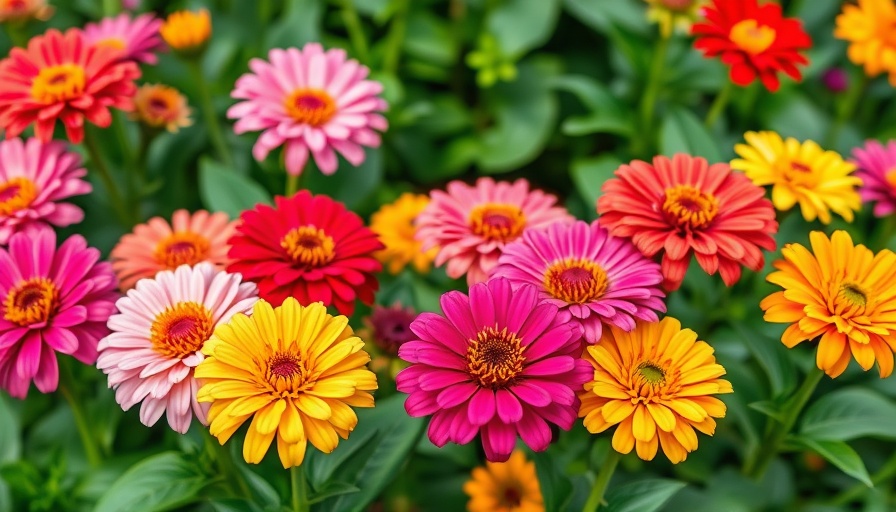
Bringing Color to Your Garden: The Vibrancy of Zinnias
Zinnias, beloved for their vibrant hues and resilience, are an essential addition to any garden. Easy to grow and remarkably colorful, these flowers can illuminate flowerbeds and provide cutting flowers that brighten up indoor spaces. Suitable for all gardeners—from seasoned florists to novices—zinnias shine in many climates, thriving from warm summer days to cooler evenings.
Why Zinnias Are a Gardener's Favorite
One of the most appealing aspects of zinnias is their adaptability. With a wide range of cultivars, they can flourish in diverse growing conditions, including drought-prone areas and moist climates. This adaptability is crucial as gardeners today face unpredictable climate patterns. Zinnias lend beauty to gardens all over the USDA Hardiness Zones 3 to 10 and offer unique advantages that make them stand out. For instance, certain varieties are not only drought-tolerant but also resistant to common garden pests, allowing homeowners to minimize their reliance on chemical pesticides.
Spotlight on 15 Remarkable Zinnia Varieties
Here’s a closer look at 15 exceptional zinnia varieties that promise to elevate your gardening experience:
- Big Red: A visual feast with big, six-inch scarlet blooms that evolve into a deep orange, ‘Big Red’ offers striking beauty and rapid growth.
- Cactus Flowered Mix: This mix features narrow, curled petals that captivate with their texture; a must-have for any garden spectacle.
- California Giant Mix: Reaching heights of four feet, these prolific blooms are perfect for showcasing alongside tall sunflowers.
- Color Crackle: Bursting with unique variegated petals, this variety provides playful vibrancy to any flowerbed.
- Crystal White: Elegant and classic, ‘Crystal White’ introduces a serene aura amidst the riot of colors.
- Dahlia Flowered Mix: Plush, multi-layered flowers create dramatic arrangements and are stunning both in the garden and as bouquet fillers.
- Double Zahara Yellow: This robust variety is not only disease-resistant but produces cheerful yellow blooms that can withstand the elements.
- Envy: A curated choice for modern gardens, ‘Envy’ offers striking green petals that can charm any passerby.
- Peppermint Stick: Dual-colored petals in pink and white evoke the holiday spirit and create delightful contrast alongside other blooms.
- Profusion Cherry: With exceptional drought resistance, this cultivar promises bright red blooms that maintain their luster.
- Queeny Lime Orange: Compact yet vibrant, this type brings a refreshing twist to your garden palette.
- State Fair Mix: A classic blend that’s sure to evoke nostalgia, suitable for garden shows and competitions.
- Swizzle Ivory and Cherry: Light and color come together effortlessly with this unique zinnia, drawing attention from admirers.
- Zinderella Lilac: Soft lilac hues stand out artistically, making this variety a sought-after choice for flower arrangements.
- Zowie Yellow Flame: An eye-catching hybrid known for its flaming color patterns, great for adding texture and depth.
Growing Zinnias: Tips for Success
Zinnias flourish in direct sunlight, making it essential to plant them where they'll receive at least six hours of sunlight daily. When sowing seeds, remember to space them adequately to prevent overcrowding, which can invite diseases. Additionally, water the plants regularly but avoid soaking the foliage to reduce the risk of fungal infections. These simple techniques will set the stage for bountiful blooms.
Embracing Gardening Community: The Social Benefits
Gardening extends beyond aesthetics; it nurtures community and connections. Swap tips, share blooms, or simply enjoy the beauty together. Engaging in gardening fosters a sense of belonging, combatting the isolation that often accompanies modern living. Whether forming a community flower garden or merely sharing your harvest with neighbors, zinnias can play a pivotal role in creating bonds.
Future Trends in Flower Gardening: Zinnias Leading the Way
As gardeners become more conscious of eco-friendly practices, zinnias are increasingly valued for their low-maintenance, high-reward nature. Many are seeking flowers that reduce water usage and resist pests, making zinnias a future mainstay. By integrating these vibrant blooms into our gardens, we can contribute to a sustainable future.
Final Thoughts: Grow Your Own Zinnia Haven
With their striking beauty, adaptability, and ability to foster connections, zinnias are truly a garden gem. Whether you’re an experienced gardener or just dipping your toes into gardening, zinnias offer vibrant colors and easy care that can elevate your outdoor space. So, why not start sowing your zinnia seeds today? Discover the joy of garden blooms and create a slice of paradise right at home!
 Add Row
Add Row  Add
Add 




 Add Row
Add Row  Add
Add 

Write A Comment